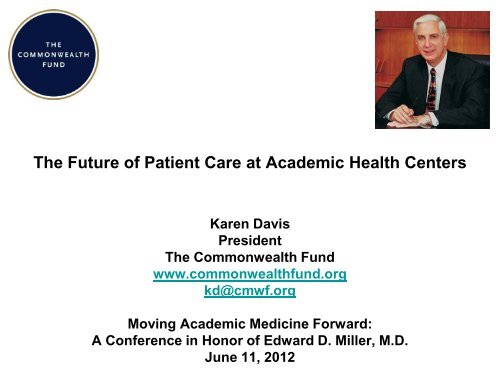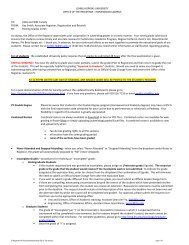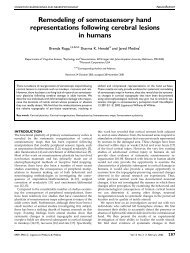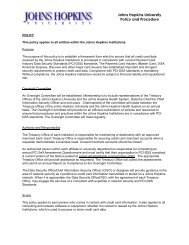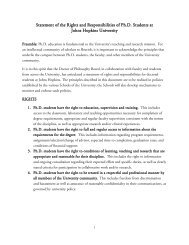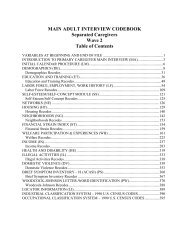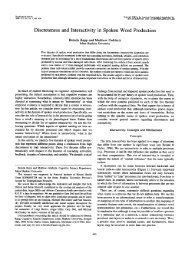Karen Davis - Johns Hopkins University
Karen Davis - Johns Hopkins University
Karen Davis - Johns Hopkins University
Create successful ePaper yourself
Turn your PDF publications into a flip-book with our unique Google optimized e-Paper software.
The Future of Patient Care at Academic Health Centers<br />
<strong>Karen</strong> <strong>Davis</strong><br />
President<br />
The Commonwealth Fund<br />
www.commonwealthfund.org<br />
kd@cmwf.org<br />
Moving Academic Medicine Forward:<br />
A Conference in Honor of Edward D. Miller, M.D.<br />
June 11, 2012
• Population-based care<br />
<strong>Johns</strong> <strong>Hopkins</strong> Medicine:<br />
A High Performance Health System<br />
• A strong primary care foundation<br />
• Coordination of a continuum of care from primary care to<br />
tertiary care to rehabilitation and home care<br />
• Committed to delivering value<br />
• Sweet spot – integration of health plan and health delivery<br />
system<br />
• Leader in research and innovation and application to the<br />
bedside<br />
• Cutting-edge technology and information system<br />
• Service to Medicaid, uninsured, and the community<br />
• Collaboration in the best interest of patients and the public<br />
• A regional, state, national, and international leader<br />
2
Commonwealth Fund Commission<br />
on a High Performance Health System<br />
– Mission: Identifying and promoting strategies<br />
and policies to achieve a high performance<br />
health system that leads to better access,<br />
improved quality, and greater efficiency<br />
– Builds on prior Commonwealth Fund work<br />
including:<br />
• Task Force on Academic Health Centers,<br />
executive director, David Blumenthal, MD<br />
• Quality Improvement Colloquium,<br />
executive director, David Blumenthal, MD<br />
• Task Force on Future of Health Insurance,<br />
chairman, James J. Mongan, MD<br />
3
The Future of Patient Care at<br />
Academic Health Centers<br />
• Strategy for Achieving a High Performance Health System<br />
• A 2020 Vision for American Health Care<br />
• How Do We Fare?<br />
– 2011 Scorecard on National Health System Performance<br />
– 2009 Scorecard on State Health System Performance<br />
– 2012 Scorecard on Local Health System Performance<br />
• What is Already Underway?<br />
– Affordable Care Act Insurance Expansion<br />
– Payment and Delivery System Changes<br />
• Payment Innovation by Private and Public Payers<br />
• Patient-Centered Medical Homes<br />
• Transitions in Care and Reducing Avoidable Rehospitalization<br />
• Accountable Care Organizations<br />
• Adoption of Health Information Technology<br />
• What Does it Mean for Academic Health Centers?<br />
4
Innovation to Achieve a<br />
High Performance Health System<br />
• Goals of a High Performance Health System<br />
• Best possible health outcomes for everyone<br />
• Access to care for all<br />
• Excellent patient experiences -- patient-centered,<br />
coordinated, high-quality care for all<br />
• Lower cost – accountable for use of resources and<br />
elimination of waste<br />
• Strategies for Moving to High Performance<br />
• Affordable health insurance and care for all<br />
• Aligning financial incentives<br />
• Delivery system reform<br />
• Quality improvement and innovation<br />
• Leadership and collaboration in the best interest of<br />
communities<br />
5
A 2020 Vision for American Health Care<br />
• Enhanced access to regular source of primary care<br />
– Timely appointments, email, and telephone<br />
consultations<br />
– Access to providers on nights and weekends without<br />
going to the emergency room<br />
• Care coordination by regular provider and assistance<br />
navigating complex specialty care<br />
• Patient reminders for preventive services and<br />
management of chronic conditions<br />
• Effective use of health information technology and<br />
application of research on what works<br />
Source: <strong>Davis</strong> K, Schoen C, Schoenbaum SC. A 2020 vision for American health care. Arch Intern Med. 2000 Dec 11-<br />
25;160(22):3357-62.<br />
6
2011 Scorecard on National Health System<br />
Performance<br />
Healthy Lives<br />
Quality<br />
Access<br />
Efficiency<br />
Equity<br />
OVERALL SCORE<br />
* Note: Includes indicator(s) not available in earlier years.<br />
57<br />
55<br />
52<br />
53<br />
53 *<br />
67<br />
67<br />
65<br />
64<br />
75<br />
73<br />
70<br />
70<br />
71<br />
75 *<br />
69<br />
71<br />
69<br />
2006 revised<br />
2008 revised<br />
2011<br />
0 100<br />
Source: Commonwealth Fund National Scorecard on U.S. Health System Performance, 2011.<br />
7
2012 Scorecard on Local Health System<br />
Performance<br />
1. St. Paul, MN<br />
306. Monroe, LA<br />
Top : St. Paul MN, Dubuque IA, Rochester MN<br />
Bottom: Shreveport LA, Jackson MS, Texarkana AR, Alexandria LA, Beaumont TX, Oxford MS, Hattiesburg MS,<br />
Monroe LA<br />
SOURCE: Commonwealth Fund Scorecard on Local Health System Performance, 2012<br />
107. Baltimore, MD<br />
9
10<br />
By 2019 Health Reform Will Reverse the Deterioration of Health Insurance<br />
Coverage for Working Age Adults over the Last Decade and<br />
1999-2000<br />
Avg = 16.6%<br />
Achieve Near Universal Coverage<br />
23% or more<br />
2019 (estimated)<br />
Avg = 9.4%<br />
19%–22.9% 14%–18.9%<br />
7.1%–13.9% 7% or less<br />
Source: Commonwealth Fund National Scorecard on U.S. Health System Performance, 2011.<br />
2009-2010<br />
Avg = 21.8%
What Is Already Underway? ACA Payment and Delivery<br />
System Reforms Support a High Performance Health System<br />
• Primary Care and Medical<br />
Homes: three new Medicare<br />
pilots, several Medicaid<br />
initiatives; increased payment<br />
for primary care<br />
• Bundled payments: Medicare<br />
pilots for hospital and postacute<br />
care, Medicaid initiatives<br />
• ACO: Broad responsibility for<br />
quality and cost of patient care,<br />
rewards for quality, shared<br />
savings<br />
• Value-based purchasing<br />
• More transparency on quality<br />
and cost<br />
• Meaningful use of health<br />
information technology<br />
Global<br />
Budget<br />
Payment Integration<br />
FFS and<br />
DRGs<br />
Payment and Delivery System Integration<br />
Small MD<br />
practice;<br />
unrelated<br />
hospitals<br />
Pioneer<br />
ACOs<br />
Comprehensive<br />
Primary Care<br />
Initiative<br />
Delivery System<br />
Integration<br />
CMMI Acute<br />
Episode Bundled<br />
Payment Pilots<br />
Source: The Commonwealth Fund, The New Wave of Innovation: How the Health Care System Is Reforming, (New York:<br />
Columbia Journalism Review, November 2011); A. Shih, K. <strong>Davis</strong>, S. Schoenbaum, A. Gauthier, R. Nuzum, and D. McCarthy,<br />
Organizing the U.S. Health Care Delivery System for High Performance (New York: The Commonwealth Fund, Aug. 2008); A.<br />
Dreyfus, The Alternative Quality Contract and ACOs: Lessons for Policy-Makers, presentation to 2012 Bipartisan<br />
Congressional Health Policy Conference, January 22, 2012.<br />
Medicare<br />
Shared<br />
Savings<br />
Plan<br />
Integrated<br />
delivery<br />
system<br />
11
Michigan BCBS Physician Group Incentive Program<br />
CY 2009, Risk-Adjusted<br />
Inpatient Admissions for Ambulatory-<br />
Care Sensitive Conditions<br />
Designated<br />
PCMHs vs.<br />
Other<br />
Practices<br />
-16.7%<br />
Re-Admissions within 30 Days -6.3%<br />
ER Visits -4.5%<br />
Standard Cost of Outpatient Care<br />
(PMPM)<br />
Standard Cost of High Tech Imaging<br />
(PMPM)<br />
Standard Cost of Low Tech Imaging<br />
(PMPM)<br />
0.5%<br />
-7.2%<br />
-7.3%<br />
Self-Referral Rate for Low Tech Imaging -51.5%<br />
Number of Practice Units<br />
participating in at least<br />
one PCMH initiative<br />
Number of Practice Units<br />
none<br />
1 - 2<br />
3 - 4<br />
5 - 9<br />
10 - 29<br />
31 or more<br />
(Total of 2190 Practice Units among 78 counties)<br />
22/09 Medical Informatics<br />
Source: C. Lemak et al., From Partisanship to Partnership: Evaluating the Physician Group Incentive Program<br />
(PGIP), (New York: The Commonwealth Fund, forthcoming 2012).<br />
12
Patient Centered Medical Homes
AK<br />
41 State Medicaid/CHIP Programs Planning/Implementing 14<br />
PCMH<br />
23 Making Medical Home Payments<br />
19 Aligning Primary Care Payment to Medical Home Standards<br />
12 Involved in Multi-Payer Pilots, 8 have Medicare as Payer<br />
OR<br />
CA<br />
HI<br />
WA<br />
NV<br />
ID<br />
UT<br />
AZ<br />
MT<br />
WY<br />
NM<br />
CO<br />
State with multi-payer initiative, Medicare as<br />
payer<br />
States aligning primary care payment to<br />
medical home standards<br />
No PCMH Medicaid Activity- 9 States<br />
Source: National Academy for State Health Policy State Scan, January 2012. http://www.nashp.org/med-home-map<br />
ND<br />
SD<br />
NE<br />
KS<br />
TX<br />
OK<br />
MN<br />
IA<br />
MO<br />
AR<br />
LA<br />
WI<br />
IL<br />
MS<br />
IN<br />
MI<br />
TN<br />
AL<br />
KY<br />
OH<br />
GA<br />
WV<br />
SC<br />
PA<br />
NC<br />
FL<br />
VA<br />
NY<br />
VT<br />
Medicare joined state multi-payer initiatives<br />
States making payments for PCMH<br />
ME<br />
RI<br />
MD<br />
NH<br />
MA<br />
Significant activity for Medicaid/ CHIP PCMH advancement<br />
14
14%<br />
Percent Readmissions<br />
13%<br />
12%<br />
11%<br />
10%<br />
9%<br />
State Action to Reduce Avoidable<br />
Rehospitalizations<br />
• STAAR program poised to inform public policy and initiatives related to care<br />
transitions and readmissions – Michigan, Massachusetts, Washington.<br />
• Preliminary national survey of hospitals suggests that STAAR hospitals are<br />
more likely to have adopted interventions such as enhanced assessments,<br />
enhanced patient education and to have activated the post acute care delivery<br />
system prior to discharge, compared to non STAAR hospitals.<br />
• Trend in STAAR cohort of hospitals in each state suggests reductions in<br />
readmissions for certain groups of patients, on targeted units or hospital-wide.<br />
– Top performers show up to 50% reduction in readmissions for targeted<br />
patient population on specific units (e.g. high risk patients with CHF)<br />
STAAR: MA Hospitals Reporting All-Cause<br />
30-Day Readmissions<br />
(All MA Reported Data)<br />
CL: 12.6%<br />
Aggregate % readmissions UCL<br />
LCL centerline<br />
# of hospitals reporting<br />
100<br />
80<br />
CL: 12.1%<br />
60<br />
40<br />
20<br />
0<br />
15%<br />
Percent Readmissions<br />
13%<br />
11%<br />
9%<br />
STAAR: MI Hospitals Reporting All-Cause<br />
30-Day Readmissions<br />
(All MI Reported Data)<br />
CL: 12.2%<br />
Aggregate % readmissions UCL<br />
LCL baseline<br />
# of hospitals reporting<br />
50<br />
40<br />
30<br />
20<br />
10<br />
0<br />
15
INTERACT – Improved Nursing Home Care<br />
Reduces Hospitalization<br />
• Interventions to Reduce Acute Care<br />
Transfers (INTERACT) II helps nursing<br />
home staff identify, assess,<br />
communicate, and document changes<br />
in residents' status<br />
• Resulted in a 17 percent reduction in<br />
hospital admissions<br />
• Three strategies:<br />
– identifying, assessing, and<br />
managing conditions to prevent<br />
them from becoming severe<br />
enough to require hospitalization;<br />
– managing selected conditions,<br />
such as respiratory and urinary<br />
tract infections, in the nursing<br />
home itself; and,<br />
– improving advance care planning<br />
and developing palliative care<br />
plans as an alternative to acute<br />
hospitalization for residents at the<br />
end of life<br />
Source: J. G. Ouslander, G. Lamb, R. Tappen et al., "Interventions to Reduce Hospitalizations from Nursing Homes:<br />
Evaluation of the INTERACT II Collaborative Quality Improvement Project," Journal of the American Geriatrics<br />
Society, April 2011 59(4):745–53.<br />
4.5<br />
4<br />
3.5<br />
3<br />
2.5<br />
2<br />
1.5<br />
1<br />
0.5<br />
0<br />
INTERACT II Shows Potential<br />
to Reduce Hospital Admissions<br />
Hospitalizations per 1,000 resident days<br />
4.01 3.96 3.99<br />
3.71<br />
3.13<br />
3.32<br />
Engaged<br />
facilities<br />
July-Dec 2008 July-Dec 2009<br />
Not egaged<br />
facilities<br />
All INTERACT II<br />
facilities<br />
2.69<br />
2.61<br />
Comparison<br />
facilities<br />
16
Private Sector<br />
Public Sector<br />
Spread of Public and Private ACO Contracts<br />
= Brookings-Dartmouth (3)<br />
= Medicare Physician Group Practice Demo (10);<br />
Medicare Health Care Quality Demos (2)<br />
= AQC (8 in Massachusetts)<br />
2009 January 2012<br />
Private Sector<br />
= Brookings-Dartmouth Pilots (5)<br />
= Premier Implementation (23)<br />
= CIGNA (12)<br />
= AQC (9 in Massachusetts)<br />
= AMGA Collaborative (16)<br />
= Other private-sector ACOs<br />
Public Sector<br />
17<br />
= Beacon Communities (13)<br />
= PGP, MHCQ (13)<br />
= Pioneer (32)<br />
Source: E. Fisher, ACO Formation: Leading the Transition to New Models of Care, Toward Accountable Care, (New<br />
York: The Commonwealth Fund, January 2012).
Red: Pioneer<br />
Blue: SSP<br />
Pioneer ACO and SSP Program Sites<br />
18
43% (2012)<br />
DesRoches<br />
19
What Does it Mean for Academic Health Centers?<br />
• Challenges<br />
– Provision of inadequately funded public goods – research, education,<br />
specialized care capacity -- contributes to higher cost and competitive<br />
disadvantage<br />
– Absence of universal health insurance adds to financial vulnerability of<br />
institutions with a mission of serving all regardless of ability to pay;<br />
Maryland and West Virginia only states with all-payer hospital system<br />
– Ability to provide patient-centered primary care and continuity of care<br />
with a reward system weighted to advanced specialized care<br />
• Opportunities<br />
– Recognition for excellence<br />
– Attract the best physicians and health professionals<br />
– Openness to evaluation and embracing change; innovation highly valued<br />
– Incorporate latest advances into care at the bedside<br />
– Experience with care models for high-cost, complex patients, dual<br />
eligibles<br />
– Performance driven; adoption of best practices<br />
– Right values -- Patient is number one<br />
20
Thank You!<br />
Tony Shih,<br />
Executive Vice<br />
President for<br />
Programs,<br />
ts@cmwf.org<br />
Cathy Schoen,<br />
Senior Vice<br />
President for<br />
Research and<br />
Evaluation,<br />
cs@cmwf.org<br />
Anne-Marie Audet,<br />
Vice President,<br />
Health System<br />
Quality and<br />
Efficiency<br />
ama@cmwf.org<br />
For more information, please visit:<br />
www.commonwealthfund.org<br />
Stu Guterman,<br />
Vice President,<br />
Payment Reform<br />
sxg@cmwf.org<br />
Melinda Abrams,<br />
Vice President,<br />
mka@cmwf.org<br />
Kristof Stremikis,<br />
Senior Research<br />
Associate,<br />
ks@cmwf.org<br />
21


